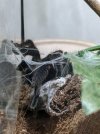- Messages
- 4,163
Upgraded our GBB's housing after 6 molts in the 14 months we've had her, from 3/4" sling to now about 2-1/2" leg span, and it's been hiding ever since.
The first day in the new enclosure it started webbing on the branches but since then it has retreated into a coconut shell hide I put in there and blocked the entrance with webbing and substrate.
My gut is to leave it alone, what good can I do digging it out, but I wonder how long it will hide in there, or if it's possibly molting in there and will dig itself out when it's ready.
What say ye other GBB keepers?
The first day in the new enclosure it started webbing on the branches but since then it has retreated into a coconut shell hide I put in there and blocked the entrance with webbing and substrate.
My gut is to leave it alone, what good can I do digging it out, but I wonder how long it will hide in there, or if it's possibly molting in there and will dig itself out when it's ready.
What say ye other GBB keepers?



